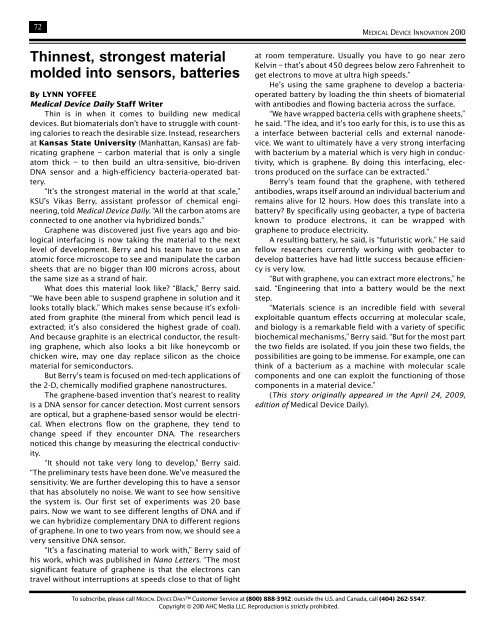MEDICAL DEVICE INNOVATION - Medical Device Daily
MEDICAL DEVICE INNOVATION - Medical Device Daily
MEDICAL DEVICE INNOVATION - Medical Device Daily
Create successful ePaper yourself
Turn your PDF publications into a flip-book with our unique Google optimized e-Paper software.
72<br />
Thinnest, strongest material<br />
molded into sensors, batteries<br />
By LYNN YOFFEE<br />
<strong>Medical</strong> <strong>Device</strong> <strong>Daily</strong> Staff Writer<br />
Thin is in when it comes to building new medical<br />
devices. But biomaterials don’t have to struggle with counting<br />
calories to reach the desirable size. Instead, researchers<br />
at Kansas State University (Manhattan, Kansas) are fabricating<br />
graphene – carbon material that is only a single<br />
atom thick – to then build an ultra-sensitive, bio-driven<br />
DNA sensor and a high-efficiency bacteria-operated battery.<br />
“It’s the strongest material in the world at that scale,”<br />
KSU’s Vikas Berry, assistant professor of chemical engineering,<br />
told <strong>Medical</strong> <strong>Device</strong> <strong>Daily</strong>. “All the carbon atoms are<br />
connected to one another via hybridized bonds.”<br />
Graphene was discovered just five years ago and biological<br />
interfacing is now taking the material to the next<br />
level of development. Berry and his team have to use an<br />
atomic force microscope to see and manipulate the carbon<br />
sheets that are no bigger than 100 microns across, about<br />
the same size as a strand of hair.<br />
What does this material look like “Black,” Berry said.<br />
“We have been able to suspend graphene in solution and it<br />
looks totally black.” Which makes sense because it’s exfoliated<br />
from graphite (the mineral from which pencil lead is<br />
extracted; it’s also considered the highest grade of coal).<br />
And because graphite is an electrical conductor, the resulting<br />
graphene, which also looks a bit like honeycomb or<br />
chicken wire, may one day replace silicon as the choice<br />
material for semiconductors.<br />
But Berry’s team is focused on med-tech applications of<br />
the 2-D, chemically modified graphene nanostructures.<br />
The graphene-based invention that’s nearest to reality<br />
is a DNA sensor for cancer detection. Most current sensors<br />
are optical, but a graphene-based sensor would be electrical.<br />
When electrons flow on the graphene, they tend to<br />
change speed if they encounter DNA. The researchers<br />
noticed this change by measuring the electrical conductivity.<br />
“It should not take very long to develop,” Berry said.<br />
“The preliminary tests have been done. We’ve measured the<br />
sensitivity. We are further developing this to have a sensor<br />
that has absolutely no noise. We want to see how sensitive<br />
the system is. Our first set of experiments was 20 base<br />
pairs. Now we want to see different lengths of DNA and if<br />
we can hybridize complementary DNA to different regions<br />
of graphene. In one to two years from now, we should see a<br />
very sensitive DNA sensor.<br />
“It’s a fascinating material to work with,” Berry said of<br />
his work, which was published in Nano Letters. “The most<br />
significant feature of graphene is that the electrons can<br />
travel without interruptions at speeds close to that of light<br />
<strong>MEDICAL</strong> <strong>DEVICE</strong> <strong>INNOVATION</strong> 2010<br />
at room temperature. Usually you have to go near zero<br />
Kelvin – that’s about 450 degrees below zero Fahrenheit to<br />
get electrons to move at ultra high speeds.”<br />
He’s using the same graphene to develop a bacteriaoperated<br />
battery by loading the thin sheets of biomaterial<br />
with antibodies and flowing bacteria across the surface.<br />
“We have wrapped bacteria cells with graphene sheets,”<br />
he said. “The idea, and it’s too early for this, is to use this as<br />
a interface between bacterial cells and external nanodevice.<br />
We want to ultimately have a very strong interfacing<br />
with bacterium by a material which is very high in conductivity,<br />
which is graphene. By doing this interfacing, electrons<br />
produced on the surface can be extracted.”<br />
Berry’s team found that the graphene, with tethered<br />
antibodies, wraps itself around an individual bacterium and<br />
remains alive for 12 hours. How does this translate into a<br />
battery By specifically using geobacter, a type of bacteria<br />
known to produce electrons, it can be wrapped with<br />
graphene to produce electricity.<br />
A resulting battery, he said, is “futuristic work.” He said<br />
fellow researchers currently working with geobacter to<br />
develop batteries have had little success because efficiency<br />
is very low.<br />
“But with graphene, you can extract more electrons,” he<br />
said. “Engineering that into a battery would be the next<br />
step.<br />
“Materials science is an incredible field with several<br />
exploitable quantum effects occurring at molecular scale,<br />
and biology is a remarkable field with a variety of specific<br />
biochemical mechanisms,” Berry said. “But for the most part<br />
the two fields are isolated. If you join these two fields, the<br />
possibilities are going to be immense. For example, one can<br />
think of a bacterium as a machine with molecular scale<br />
components and one can exploit the functioning of those<br />
components in a material device.”<br />
(This story originally appeared in the April 24, 2009,<br />
edition of <strong>Medical</strong> <strong>Device</strong> <strong>Daily</strong>).<br />
To subscribe, please call <strong>MEDICAL</strong> <strong>DEVICE</strong> DAILY Customer Service at (800) 888-3912; outside the U.S. and Canada, call (404) 262-5547.<br />
Copyright © 2010 AHC Media LLC. Reproduction is strictly prohibited.
















